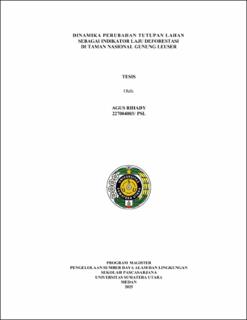Dinamika Perubahan Tutupan Lahan sebagai Indikator Laju Deforestasi di Taman Nasional Gunung Leuser
Land Cover Change Dynamics as An Indicator of Deforestation Rate in Mount Leuser National Park

Date
2025Author
Rihady, Agus
Advisor(s)
Rahmawaty
Aththorick, T Alief
Metadata
Show full item recordAbstract
Gunung Leuser National Park (GLNP) is one of the most important conservation areas in Indonesia which functions as a habitat for various rare and protected species, such as tigers, elephants, rhinos, and Sumatran orangutans. However, this area faces serious threats in the form of deforestation caused by human activities, such as illegal logging, agricultural land expansion, and infrastructure development. This study aims to analyze the rate of deforestation that occurred in the TNGL area from 2008 to 2023, analyze changes in land cover in the TNGL area in 2033 and analyze the attitudes, perceptions and participation of the community towards the rate of deforestation that occurred in the TNGL area. The methods used include multi-temporal satellite imagery analysis (Landsat 5 and 8) with a supervised classification approach (supervised classification) using Google Earth Engine (GEE) and Geographic Information System (GIS) tools. In addition, data accuracy testing was carried out with ground truth and assessment of perception and participation of the surrounding community towards changes in land cover. The results of the study indicate that during 2003–2023, the TNGL forest experienced an average cover decline of 1,245.84 ha/year due to encroachment, plantation expansion, development, and weak law enforcement, although it still dominates >90% of the area. Projections until 2033 indicate a potential loss of approximately 6,127.58 ha, with increasing open land and settlements. On the other hand, the community has active participation, good perception and positive attitude towards forest conservation, showing their willingness to be actively involved in maintaining the sustainability of the TNGL ecosystem.
